A caldera is a large cauldron-like hollow that forms shortly after the emptying of a magma chamber in a volcanic eruption. When large volumes of magma are erupted over a short time, structural support for the rock above the magma chamber is lost. The ground surface then collapses downward into the emptied or partially emptied magma chamber, leaving a massive depression at the surface. Although sometimes described as a crater, the feature is actually a type of sinkhole, as it is formed through subsidence and collapse rather than an explosion or impact. Only seven caldera-forming collapses are known to have occurred since 1900, most recently at Bárðarbunga volcano, Iceland in 2014.
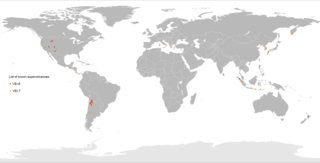
A supervolcano is a large volcano that has had an eruption with a Volcanic Explosivity Index (VEI) of 8, the largest recorded value on the index. This means the volume of deposits for that eruption is greater than 1,000 cubic kilometers.

A volcano is a rupture in the crust of a planetary-mass object, such as Earth, that allows hot lava, volcanic ash, and gases to escape from a magma chamber below the surface.

Rhyolite is the most silica-rich of volcanic rocks. It is generally glassy or fine-grained (aphanitic) in texture, but may be porphyritic, containing larger mineral crystals (phenocrysts) in an otherwise fine-grained rock. The mineral assemblage is predominantly quartz, sanidine and plagioclase. It is the extrusive equivalent to granite.
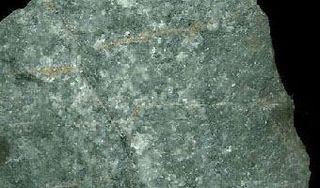
Dacite is a volcanic rock formed by rapid solidification of lava that is high in silica and low in alkali metal oxides. It has a fine-grained (aphanitic) to porphyritic texture and is intermediate in composition between andesite and rhyolite. It is composed predominantly of plagioclase feldspar and quartz.

Pyroclastic rocks are clastic rocks composed of rock fragments produced and ejected by explosive volcanic eruptions. The individual rock fragments are known as pyroclasts. Pyroclastic rocks are a type of volcaniclastic deposit, which are deposits made predominantly of volcanic paticles. 'Phreatic' pyroclastic deposits are a variety of pyroclastic rock that forms from volcanic steam explosions and they are made entirely made of accidental clasts. 'Phreatomagmatic' pyroclastic deposits are formed from explosive interaction of magma with groundwater.

A magma chamber is a large pool of liquid rock beneath the surface of the Earth. The molten rock, or magma, in such a chamber is less dense than the surrounding country rock, which produces buoyant forces on the magma that tend to drive it upwards. If the magma finds a path to the surface, then the result will be a volcanic eruption; consequently, many volcanoes are situated over magma chambers. These chambers are hard to detect deep within the Earth, and therefore most of those known are close to the surface, commonly between 1 km and 10 km down.
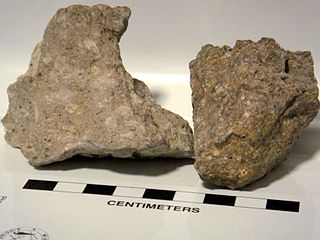
Ignimbrite is a variety of hardened tuff. Ignimbrites are igneous rocks made up of crystal and rock fragments in a glass-shard groundmass, albeit the original texture of the groundmass might be obliterated due to high degrees of welding. The term ignimbrite is not recommended by the IUGS Subcommission on the Systematics of Igneous Rocks.
George Patrick Leonard Walker was a British geologist who specialized in mineralogy and volcanology.

La Garita Caldera is a large supervolcanic caldera in the San Juan volcanic field in the San Juan Mountains near the town of Creede in southwestern Colorado, United States. It is west of La Garita, Colorado. The eruption that created the La Garita Caldera is among the largest known volcanic eruptions in Earth's history, as well as being one of the most powerful known supervolcanic events.

An effusive eruption is a type of volcanic eruption in which lava steadily flows out of a volcano onto the ground. There are two major groupings of eruptions: effusive and explosive. Effusive eruption differs from explosive eruption, wherein magma is violently fragmented and rapidly expelled from a volcano. Effusive eruptions are most common in basaltic magmas, but they also occur in intermediate and felsic magmas. These eruptions form lava flows and lava domes, each of which vary in shape, length, and width. Deep in the crust, gasses are dissolved into the magma because of high pressures, but upon ascent and eruption, pressure drops rapidly, and these gasses begin to exsolve out of the melt. A volcanic eruption is effusive when the erupting magma is volatile poor, which suppresses fragmentation, creating an oozing magma which spills out of the volcanic vent and out into the surrounding area. The shape of effusive lava flows is governed by the type of lava, rate and duration of eruption, and topography of the surrounding landscape.

The Oruanui eruption of New Zealand's Taupo Volcano, the world's most recent supereruption, had a Volcanic Explosivity Index of 8. It is one of the largest eruptions in the history of New Zealand. It occurred at about 26,500 BC in the Late Pleistocene and generated approximately 430 km3 (100 cu mi) of pyroclastic fall deposits, 320 km3 (77 cu mi) of pyroclastic density current (PDC) deposits and 420 km3 (100 cu mi) of primary intracaldera material, equivalent to 530 km3 (130 cu mi) of magma, totaling 1,170 km3 (280 cu mi) of total deposits. The eruption is divided into 10 different phases on the basis of nine mappable fall units and a tenth, poorly preserved but volumetrically dominant fall unit.
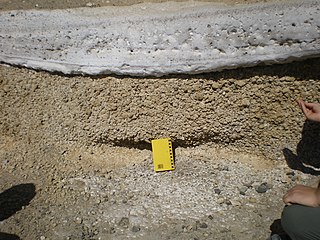
Phreatomagmatic eruptions are volcanic eruptions resulting from interaction between magma and water. They differ from exclusively magmatic eruptions and phreatic eruptions. Unlike phreatic eruptions, the products of phreatomagmatic eruptions contain juvenile (magmatic) clasts. It is common for a large explosive eruption to have magmatic and phreatomagmatic components.

The Hatepe eruption, named for the Hatepe Plinian pumice tephra layer, sometimes referred to as the Taupo eruption and dated to either around 180 or 233 CE was Taupo Volcano's most recent major eruption. It is considered New Zealand's largest eruption during the last 20,000 years. The eruption ejected some 120 km3 (29 cu mi) of material, of which 30 km3 (7.2 cu mi) was ejected in a few minutes. This makes it one of the largest eruptions in the last 5,000 years, comparable to the Minoan eruption in the 2nd millennium BCE, the 946 eruption of Paektu Mountain, the 1257 eruption of Mount Samalas, and the 1815 eruption of Mount Tambora.

The volcanism of New Zealand has been responsible for many of the country's geographical features, especially in the North Island and the country's outlying islands.
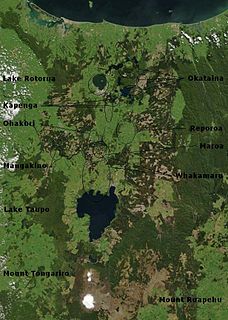
Lake Taupo, in the centre of New Zealand’s North Island, is the caldera of a large rhyolitic supervolcano called the Taupo Volcano. This huge volcano has produced two of the world’s most violent eruptions in geologically recent times.
Bruce F. Houghton is a New Zealand volcanologist. He was born on 29 April 1950 in Auckland, New Zealand. He was a student at Auckland University, and University of Otago.

Volcanic ash consists of fragments of rock, minerals, and volcanic glass, created during volcanic eruptions and measuring less than 2 mm (0.079 inches) in diameter. The term volcanic ash is also often loosely used to refer to all explosive eruption products, including particles larger than 2 mm. Volcanic ash is formed during explosive volcanic eruptions when dissolved gases in magma expand and escape violently into the atmosphere. The force of the gasses shatters the magma and propels it into the atmosphere where it solidifies into fragments of volcanic rock and glass. Ash is also produced when magma comes into contact with water during phreatomagmatic eruptions, causing the water to explosively flash to steam leading to shattering of magma. Once in the air, ash is transported by wind up to thousands of kilometres away.















